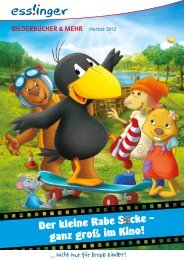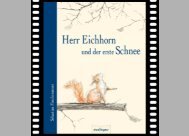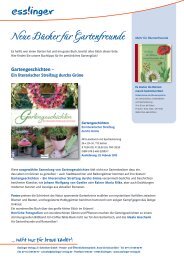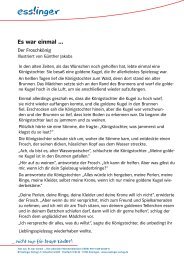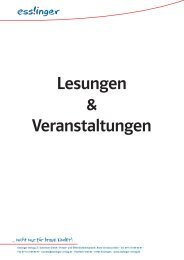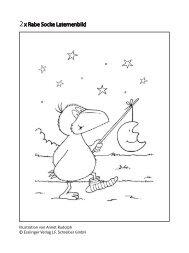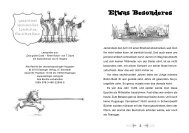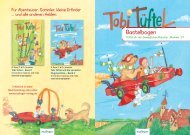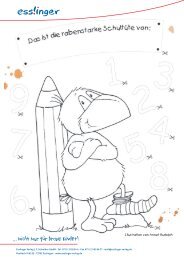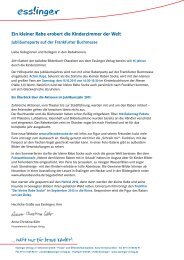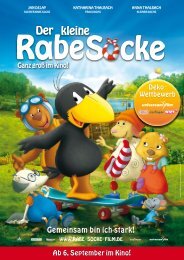Interview with Andrej Dugin and Olga Dugina (on January, 26th, 2010)
Interview with Andrej Dugin and Olga Dugina (on January, 26th, 2010)
Interview with Andrej Dugin and Olga Dugina (on January, 26th, 2010)
Create successful ePaper yourself
Turn your PDF publications into a flip-book with our unique Google optimized e-Paper software.
<str<strong>on</strong>g>Interview</str<strong>on</strong>g> <str<strong>on</strong>g>with</str<strong>on</strong>g> <str<strong>on</strong>g>Andrej</str<strong>on</strong>g> <str<strong>on</strong>g>Dugin</str<strong>on</strong>g> <str<strong>on</strong>g>and</str<strong>on</strong>g> <str<strong>on</strong>g>Olga</str<strong>on</strong>g> <str<strong>on</strong>g>Dugin</str<strong>on</strong>g>a (<strong>on</strong> <strong>January</strong>, <strong>26th</strong>, <strong>2010</strong>)<br />
1.) How is the work to interpret tales which are pitched <str<strong>on</strong>g>and</str<strong>on</strong>g> published so many years ago?<br />
All of us were actually w<strong>on</strong>dering about this questi<strong>on</strong>, as we haven’t really understood it. But neverthe-<br />
less <str<strong>on</strong>g>Andrej</str<strong>on</strong>g> <str<strong>on</strong>g>and</str<strong>on</strong>g> the rest of us tried to answer it as follows:<br />
Esslinger Verlag <strong>on</strong>ce decided to start publishing more classical <str<strong>on</strong>g>and</str<strong>on</strong>g> general known Fairy Tales, as before<br />
that we published a couple of author’s fairy tales that were not know to the public <str<strong>on</strong>g>and</str<strong>on</strong>g> these were<br />
not very successful.<br />
Back then the former managing director <str<strong>on</strong>g>and</str<strong>on</strong>g> the editorial director chose popular classical fairy tales,<br />
because they are known to a majority of the populati<strong>on</strong>. The <str<strong>on</strong>g>Dugin</str<strong>on</strong>g>’s being artists <str<strong>on</strong>g>and</str<strong>on</strong>g> having a university<br />
degree in classical art <str<strong>on</strong>g>and</str<strong>on</strong>g> design were thus keen <strong>on</strong> getting the job of illustrating these fairy tales<br />
for Esslinger then.<br />
2.) At „Das tapfere Schneiderlein“ <str<strong>on</strong>g>and</str<strong>on</strong>g> „Die Drachenfedern“ the illustrati<strong>on</strong>s tell a parallel tale al<strong>on</strong>gside<br />
to the original narrati<strong>on</strong>. Could you comment this appeal?<br />
<str<strong>on</strong>g>Andrej</str<strong>on</strong>g>’s general intenti<strong>on</strong> was, that the readers could ‘read’ the story <str<strong>on</strong>g>with</str<strong>on</strong>g>out even reading the text,<br />
just by looking at the illustrati<strong>on</strong>s, which tell a story <strong>on</strong> their own. Thus, he wanted to tickle the reader’s<br />
attenti<strong>on</strong> <str<strong>on</strong>g>and</str<strong>on</strong>g> to inspire his phantasy. <str<strong>on</strong>g>Olga</str<strong>on</strong>g> told us that, <strong>on</strong>ce the books were published they received<br />
many letters from children <str<strong>on</strong>g>and</str<strong>on</strong>g> kids, who even explained the symbols <str<strong>on</strong>g>and</str<strong>on</strong>g> above that invented own<br />
stories <str<strong>on</strong>g>with</str<strong>on</strong>g> regard to the illustrati<strong>on</strong>s <str<strong>on</strong>g>and</str<strong>on</strong>g> symbols. This was amazing <str<strong>on</strong>g>and</str<strong>on</strong>g> exactly the aim that <str<strong>on</strong>g>Andrej</str<strong>on</strong>g><br />
wanted to achive. <str<strong>on</strong>g>Andrej</str<strong>on</strong>g> told us that children do not need as much explanati<strong>on</strong>s as adults do in general.<br />
Children, so he says, are more capable to do the so-called ‘free-interpretati<strong>on</strong>’, which is very good<br />
<str<strong>on</strong>g>and</str<strong>on</strong>g> crucial for their social <str<strong>on</strong>g>and</str<strong>on</strong>g> educati<strong>on</strong>al development.<br />
3.) Could you explain how does arise the esthetic creati<strong>on</strong> of the characters, that became like your<br />
trademark?<br />
4.) About “Die Drachenfedern” could you please explain some elements in the images, like the letters,<br />
flutes <str<strong>on</strong>g>and</str<strong>on</strong>g> c<str<strong>on</strong>g>and</str<strong>on</strong>g>lesticks.<br />
© Esslinger Verlag J. F. Schreiber GmbH . Postfach 10 03 25 . 73703 Esslingen . www.esslinger-verlag.de
We decided to pick up the title “Die Drachenfedern”, in order to explain the symbolism <str<strong>on</strong>g>and</str<strong>on</strong>g> illustrati<strong>on</strong>s<br />
in more detail. So we went through the individual pages <str<strong>on</strong>g>and</str<strong>on</strong>g> picked up various single signs <str<strong>on</strong>g>and</str<strong>on</strong>g> symbols:<br />
<str<strong>on</strong>g>Andrej</str<strong>on</strong>g> sporadically used stylistic methods that <strong>on</strong>ce had been used by artists like Breugel, Kranach<br />
<str<strong>on</strong>g>and</str<strong>on</strong>g> others from that period, this is why he added single letters <str<strong>on</strong>g>and</str<strong>on</strong>g> abbreviati<strong>on</strong>s like the ‘K’ for<br />
Kranach <str<strong>on</strong>g>and</str<strong>on</strong>g> ‘B’ for Breugel, etc. to the illustrati<strong>on</strong>s. He did that as ‘hommage’ to these artists.<br />
By studying their works <str<strong>on</strong>g>and</str<strong>on</strong>g> adapting some of their techniques, he also developed his individual style<br />
of illustrating.<br />
The symbols in “Die Drachenfedern”: In older story telling the drag<strong>on</strong> st<str<strong>on</strong>g>and</str<strong>on</strong>g>s for the four elements: fire,<br />
water, air <str<strong>on</strong>g>and</str<strong>on</strong>g> soil, which symbolize the the circle of life, which is the core of the story of the Drag<strong>on</strong>feathers<br />
as well. All these elements are thus picked up <str<strong>on</strong>g>and</str<strong>on</strong>g> illustrated <strong>on</strong> various pages, like e. g. the ‚river’,<br />
<strong>on</strong> which the fairy boat goes, the wind in the tree near the river, etc.<br />
C<str<strong>on</strong>g>and</str<strong>on</strong>g>lestickes: <str<strong>on</strong>g>Andrej</str<strong>on</strong>g> emphasized that the c<str<strong>on</strong>g>and</str<strong>on</strong>g>lesticks do not have any meaning, like the backpipes<br />
as well d<strong>on</strong>’t have <strong>on</strong>e. But <strong>on</strong> the last page there is this little guy, carrying c<str<strong>on</strong>g>and</str<strong>on</strong>g>les <strong>on</strong> his hat, probably<br />
you thought of him? <str<strong>on</strong>g>Andrej</str<strong>on</strong>g> told us that in the past artists did that, they put c<str<strong>on</strong>g>and</str<strong>on</strong>g>les <strong>on</strong> their hat in order<br />
to be able to work as well when it’s dark.<br />
House of the drag<strong>on</strong>: The drag<strong>on</strong> being a creature of the underworld, is known to be a scientist <str<strong>on</strong>g>and</str<strong>on</strong>g> alchemist<br />
as well. In his house a couple of things seem to be kind of disordered or somehow odd, like e.<br />
g. the window being stick directly to the stair rail. <str<strong>on</strong>g>Andrej</str<strong>on</strong>g> thus wanted to express that normality in this<br />
‘world’ is abrogated. (this could be compared a bit to the world of Alice in W<strong>on</strong>derl<str<strong>on</strong>g>and</str<strong>on</strong>g>). <str<strong>on</strong>g>Andrej</str<strong>on</strong>g> said that<br />
he added the further little ‘items’ to the illustrated story in order to just tickle the reader’s attenti<strong>on</strong>.<br />
All in all <strong>on</strong>e could say that ‘Die Drachenfedern’ tells us the story of the circle of life, so that all symbols<br />
recur several times.<br />
© Esslinger Verlag J. F. Schreiber GmbH . Postfach 10 03 25 . 73703 Esslingen . www.esslinger-verlag.de
Questi<strong>on</strong>s to <str<strong>on</strong>g>Olga</str<strong>on</strong>g> <str<strong>on</strong>g>Dugin</str<strong>on</strong>g>a - Die schönsten Märchen aus 1001 Nacht<br />
1.) Which means Sherazade’s representati<strong>on</strong> at „Die schönsten Märchen aus 1001 Nacht“? She turns as a<br />
bird in the illustrati<strong>on</strong>s. What does that tell us about the character?<br />
When starting the research for the work <strong>on</strong> “Die schönsten Märchen aus 1001 Nacht” <str<strong>on</strong>g>Olga</str<strong>on</strong>g> studied intensely<br />
the arab <str<strong>on</strong>g>and</str<strong>on</strong>g> m<strong>on</strong>golian mythology. As the stories from the 1001 nights are dated back to Persia<br />
during the period of the Mogul, where <str<strong>on</strong>g>and</str<strong>on</strong>g> when these tales obviously arised. She found out that in the<br />
arab mythology there exists a mythical creature that c<strong>on</strong>sists out of the body of a bird <str<strong>on</strong>g>and</str<strong>on</strong>g> the head of<br />
a human being. This being is sitting in a tree <str<strong>on</strong>g>and</str<strong>on</strong>g> people say that when you st<str<strong>on</strong>g>and</str<strong>on</strong>g> below this tree <str<strong>on</strong>g>and</str<strong>on</strong>g><br />
listen to it you learn about the mysteries of life <str<strong>on</strong>g>and</str<strong>on</strong>g> the universe. As Shereazade is known for her wisdom<br />
<str<strong>on</strong>g>Olga</str<strong>on</strong>g> found this mystic being perfect as model for developing Sherazade’s character.<br />
2.) The illustrati<strong>on</strong>s from this book are much different than „Das tapfere Schneiderlein“ und „Die Drachenfedern“,<br />
where you <str<strong>on</strong>g>and</str<strong>on</strong>g> <str<strong>on</strong>g>Andrej</str<strong>on</strong>g> <str<strong>on</strong>g>Dugin</str<strong>on</strong>g> were co-workers. What is the difference between illustrating<br />
<strong>on</strong> your own <str<strong>on</strong>g>and</str<strong>on</strong>g> working together <str<strong>on</strong>g>with</str<strong>on</strong>g> him? How is the illustrating process when it’s made in a partnership?<br />
When <str<strong>on</strong>g>Olga</str<strong>on</strong>g> was working together <str<strong>on</strong>g>with</str<strong>on</strong>g> Andej <strong>on</strong> the first two books, she was still studying at university,<br />
so that this period was her year of apprenticeship.<br />
She revealed us, that during that time <str<strong>on</strong>g>Andrej</str<strong>on</strong>g> was like her teacher <str<strong>on</strong>g>and</str<strong>on</strong>g> he was very severe. In the beginning<br />
she was just allowed to do the patterns <strong>on</strong> the endpapers or just colouring <str<strong>on</strong>g>and</str<strong>on</strong>g> little scribbles<br />
works. But she thus obviously learned quite a lot. When later she worked <strong>on</strong> her so-to-say ‘chefd’oeuvre’<br />
„Die schönsten Märchen aus 1001 Nacht“, she worked completely indipendently <str<strong>on</strong>g>and</str<strong>on</strong>g> was free<br />
to realize her own individual style. Today both are equal partners in work <str<strong>on</strong>g>and</str<strong>on</strong>g> obviously <str<strong>on</strong>g>Andrej</str<strong>on</strong>g> asks her<br />
for advice quite often as well.<br />
© Esslinger Verlag J. F. Schreiber GmbH . Postfach 10 03 25 . 73703 Esslingen . www.esslinger-verlag.de




